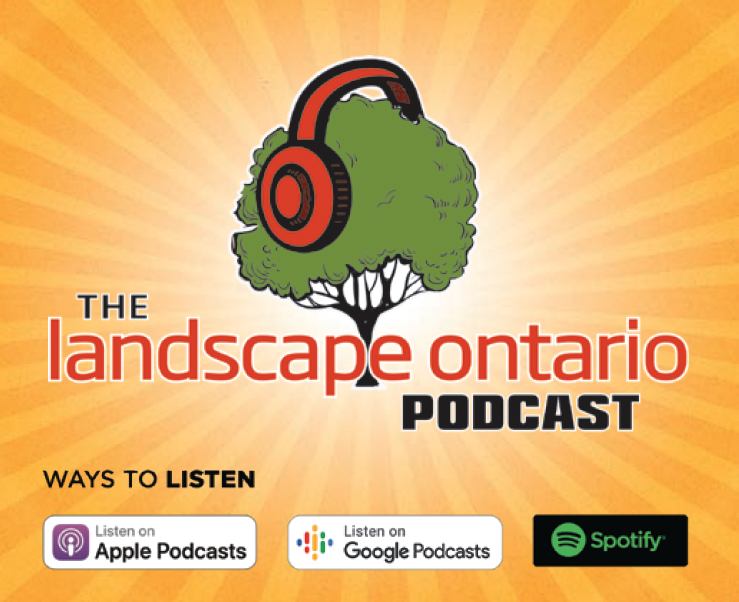
Plants are the lungs of our cities
Plants are the lungs of our cities
Landscape Ontario Podcast host interviews Green Cities Foundation Chair Alan White
Alan White is a champion for the power of plants to clean the air we breathe, cool our cities, and capture carbon. White often says that plants are the lungs of our cities, and landscape horticulture professionals are critical to climate change mitigation and adaptation.
White is the owner of the Burlington-Ont. based lawn care and irrigation firm Turf Systems. He also volunteers with the Canadian Nursery Landscape Association (CNLA) as chair of the Climate Change Adaptation Committee and chair of the Green Cities Foundation. He is also a director on Landscape Ontario’s Provinical Board.
White recently joined the Landscape Ontario Podcast to discuss why now is the time to capture the attention of public policymakers, governments, and most importantly, the general public to ensure they recognize the value of what green professionals do: growing, designing, building and maintaining green spaces.
How did you get engaged on the climate change topic?
For the last couple of decades, the story around climate change mitigation has been the ability to manage our carbon footprint. The emissions side has been the dominant piece of it. However, being part of the horticulture industry and understanding that plants are at the core of intercepting carbon, I was curious why plants weren’t part of the conversation. Why wasn’t anyone looking at the other side of the equation; the power of plants to sequester carbon while at the same time producing cleaner, cooler air?
I believe if our industry can work together to share that story, that story, there is incredible potential to make a positive impact and to be leaders on this critical issue. We can ensure plants play an essential role in the race to net zero.
Why haven’t plants been part of the conversation?
A lot of it has to do with the fact that it’s something we learned in grade nine or 10 science. We all know plants capture carbon and produce clean oxygen, but it’s almost too simple or obvious. So we look for complex solutions. And when you have a conversation with someone about where clean air comes from, people look at you with kind of astonished look, because they knew that, but they had never applied it to climate change adaptation before.
If we can shift the public’s understanding, I know we have a compelling story to tell. Plants are something that everybody can participate in. It doesn’t matter if it’s turf grass, the flowers in your garden, a tomato plant on your balcony or a tree — all of them metabolize carbon the same way, and the result is they all capture carbon and produce oxygen.
Of course, like every industry, horticulture professionals have a carbon footprint. We have inputs like fertilizer, and water. We utilize vehicles and equipment that use fossil fuels. Do we need to understand what we’re doing to mitigate our emissions? Absolutely. Can we be better at it? We can always strive to be better, but we genuinely need to understand how the inputs, the things that support life in urban ecosystems like water, nurturance and care, how do those things contribute to carbon carbon sequestration and the production of clean air? And we need to recognize as an industry that we are unique in that there is nothing outside of plants that contributes in a positive way to the carbon equation. So let’s focus on that positive while striving to be as efficient as possible.
.jpg)
How do we ensure horticulture professionals are part of the solution?
That’s the big question I’ve been working on really for the past two decades. Something I learned early on in business is that you need to be unique in what it is that you’re bringing to the marketplace. You need to have a solution and a story that is uniquely yours and allows you to rally around it and make a difference. And you also need to be able to measure it. You have to quantify what it is you want to change. And then, through that quantification, build the power of participation.
Our industry has an incredible network, when you look at the more than 4,000 CNLA members across the country, and the tens of thousands of people who work for those companies, and then expand out to the millions of clients who are positively impacted by the work that we do. There’s immense power in that network if we can find a way to harness it. That’s why the Green Cities Foundation is working hard to develop a clean air calculator that everyone — industry professionals and the general public — can use to measure the positive impact they are making with plants.
How does the clean air calculator work?
The Green Cities Foundation aims to connect plants and people for a greener, healthier urban climate. That includes both the individual level — what am I doing in my yard or balcony to produce oxygen — and the group level with the #GreenMyCity initiative. Those projects engage and empower people to participate alongside professionals to make a difference in the community.
The next step with the clean air calculator is to empower people to measure the impact that plants, shrubs, understory landscape, grass and open green spaces contribute to the environment. By providing the tool to quantify the impact of plants, our goal is to give people hope that they can make a positive difference in their communities
